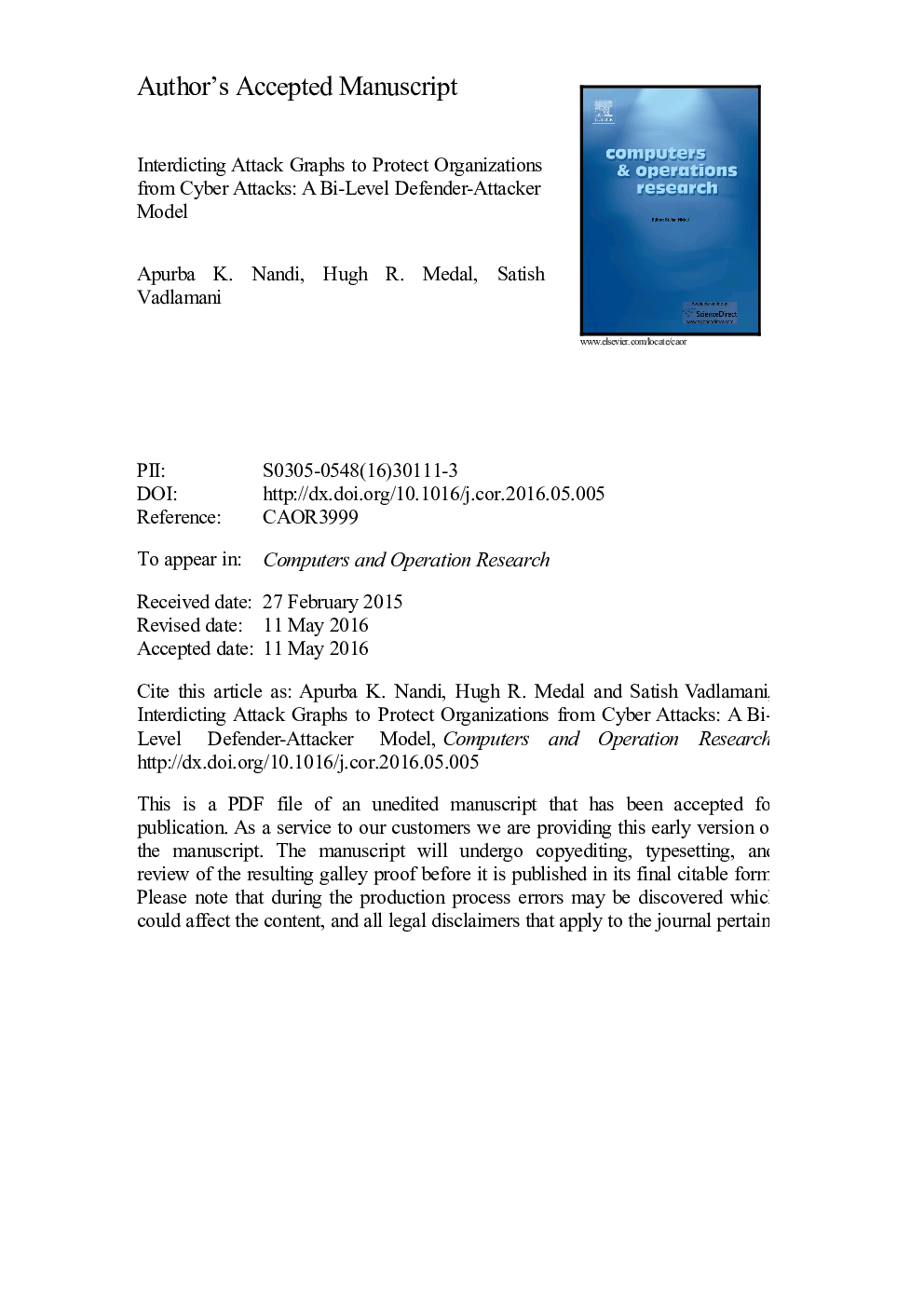| کد مقاله | کد نشریه | سال انتشار | مقاله انگلیسی | نسخه تمام متن |
|---|---|---|---|---|
| 6892751 | 699336 | 2016 | 29 صفحه PDF | دانلود رایگان |
عنوان انگلیسی مقاله ISI
Interdicting attack graphs to protect organizations from cyber attacks: A bi-level defender-attacker model
ترجمه فارسی عنوان
هکرهای حمله ممنوع برای محافظت از سازمانها از حملات سایبری: یک مدافع دوطرفه
دانلود مقاله + سفارش ترجمه
دانلود مقاله ISI انگلیسی
رایگان برای ایرانیان
کلمات کلیدی
گراف حمله ممنوعیت سطح بی، برنامه نویسی عدد صحیح مختلط، مدافع حمله کننده، امنیت سایبری،
ترجمه چکیده
سازمان های امروز به طور ذاتی باز و متصل هستند، به اشتراک گذاری دانش و ایده ها به منظور نوآوری باقی می ماند. در نتیجه، این سازمان ها نیز به دلیل سرقت اطلاعات از طریق اشکال مختلف نقض های امنیتی ناشی از هکرها و رقبا، آسیب پذیرتر هستند. یکی از راه های درک آسیب پذیری یک سیستم اطلاعاتی، ایجاد و تحلیل نمودار حمله این سیستم است. گراف حمله یک سیستم اطلاعاتی شامل تمام مسیرهایی است که می تواند برای نفوذ به سیستم برای خراب کردن دارایی های حیاتی استفاده شود. گرچه ادبیات موجود، فراوانی الگوریتم های تولید ژن حمله را فراهم می کند، برای تجزیه و تحلیل نمودارهای حمله، روش های بیشتری نیاز است. در این مقاله، ما بررسی می کنیم که چگونه با استفاده از تجزیه و تحلیل آسیب پذیری سازمان از طریق استفاده از گراف حمله آن، بهترین راه مقابله با اقدامات امنیتی را برای محافظت از سازمان حفاظت می کنیم. به طور خاص، ما یک رویکرد برای پیدا کردن یک زیرمجموعه مناسب مقرون به صرفه از قوس ها، به نام یک برنامه ممنوعیت، در یک گراف حمله است که باید از حمله محافظت شود تا زیان ناشی از نقض امنیت را کاهش دهد. ما این مشکل را به صورت یک برنامه خطی عدد صحیح دو سطحی در نظر می گیریم و یک الگوریتم دقیق برای حل آن را ایجاد می کنیم. آزمایشات نشان می دهد که الگوریتم قادر به حل مسائل نسبتا بزرگ است. دو روش اکتشافی، یکی با یک و دیگری بدون یک اکتشافی برای حل مشکل اصلی و هر دو محدود کردن درخت شاخه و دامنه تنها به یک گره، مشکلات زیادی را به طرز قابل توجهی حل می کند. آزمایش ها همچنین نشان می دهد که کیفیت یک طرح ممنوعیت نسبتا غیر حساس به نظر خطا در برآورد بودجه مهاجم است و این که افت نقص در ابتدا به شدت کاهش می یابد و سپس سطح را کاهش می دهد و در نهایت به شدت کاهش می یابد با افزایش امنیت بودجه.
موضوعات مرتبط
مهندسی و علوم پایه
مهندسی کامپیوتر
علوم کامپیوتر (عمومی)
چکیده انگلیسی
Today's organizations are inherently open and connected, sharing knowledge and ideas in order to remain innovative. As a result, these organizations are also more vulnerable to information theft through different forms of security breaches caused by hackers and competitors. One way of understanding the vulnerability of an information system is to build and analyze the attack graph of that system. The attack graph of an information system contains all the paths that can be used to penetrate the system in order to breach critical assets. Although existing literature provides an abundance of attack graph generation algorithms, more methods are required to help analyze the attack graphs. In this paper, we study how best to deploy security countermeasures to protect an organization by analyzing the vulnerability of the organization through the use of its attack graph. In particular, we present an approach to find an optimal affordable subset of arcs, called an interdiction plan, on an attack graph that should be protected from attack to minimize the loss due to security breaches. We formulate this problem as a bi-level mixed-integer linear program and develop an exact algorithm to solve it. Experiments show that the algorithm is able to solve relatively large problems. Two heuristic methods, one with and the other without a heuristic to solve the master problem and both limiting the master problem branch-and-bound tree to only one node solve the large problems remarkably well. Experiments also reveal that the quality of an interdiction plan is relatively insensitive with respect to the error in the estimate of the attacker's budget, and that the breach loss drops sharply at the beginning, then levels off before finally dropping sharply again with increases in the security budget.
ناشر
Database: Elsevier - ScienceDirect (ساینس دایرکت)
Journal: Computers & Operations Research - Volume 75, November 2016, Pages 118-131
Journal: Computers & Operations Research - Volume 75, November 2016, Pages 118-131
نویسندگان
Apurba K. Nandi, Hugh R. Medal, Satish Vadlamani,
